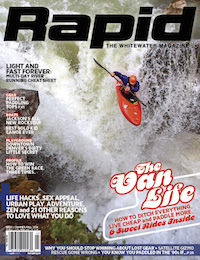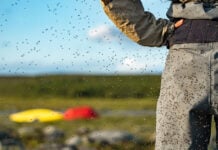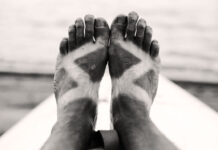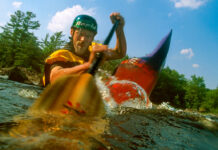The guy beside me in this photo is Patrick Hagg, a web analyst at the federal Institute of Health Research. He has a degree from a good school. He is married and has three beautiful children. His family runs, skis, snowshoes, spins and is training for alpine trekking. They are going to climb Bishorn, a 4,153-meter mountain in the Pennine Alps in Switzerland where he will celebrate his 40th birthday.
Demographically speaking, the Haggs should be a whitewater family. Except Patrick’s never paddled whitewater before.
Patrick followed my friend, photographer and longtime raft guide, Rob Faubert out of the city. Rob and Patrick work in the same department, two desks away from each other. I’d roped Rob into coming to the Hell or High Water festival to shoot some photos and help me test the new Aire Sabertooth.
Patrick spent his youth dreaming of being a National Geographic photographer and came along to shoot the action to add to his portfolio. At the last minute he threw in his diving wetsuit and a downhill ski helmet.
Where the Petawawa River snakes through the town of the same name, there’s a perfect venue for a large-scale whitewater event. The municipal walking and biking path winds past a perfect amphitheater rock right beside Lovers—the most exciting and biggest rapid of the section.
Crowds gather to cheer racers, secretly hoping for carnage in the Windigo Hole or the three raft-munching waves below.
After Rob and I had ran the Sabertooth inflatable cataraft down a few times we told Patrick to get his gear out of his car.

GROWING THE SPORT OF WHITEWATER
We paddlers talk a lot about growing the sport and getting new people into whitewater. Truth is, it’s not easy.
You either take them to quiet class I and II and spend your precious weekend teaching strokes and maneuvers in a friendly, safe and boring environment, or you run them down bigger sections of rivers you’d rather paddle. They swim lots. Anxiety and exhaustion overrides excitement and exhilaration. Real learning is low. Very few return.
Patrick, however, is hooked.
“I think first hand exposure is what did it. Being able to go down these huge rapids in a small two-person raft as a newbie gave me an incredible feeling. I played a role in successfully riding the rapids.”
We ran him through big rapids, but didn’t send him by himself. He learned about reading water, because I was right there to teach him. It was exciting for him, yet not too scary.
Whitewater tandem canoes in capable hands can work the same way.
Inflatable ducky kayaks are very stable and confidence inspiring. No cockpit means no skirt and no fear of being stuck inside. Self-rescues are easy.
We just received for review a shipment of Fluid Kayaks’ Do It Now sit-on-tops, which offer this same freedom but paddle like hard shell whitewater kay- aks. Industry rumors suggest we’ll see more of this type of boat on the market in 2015. I don’t care if we’re creating a whole new category of whitewater boats or if they’ll be stepping stones.
If not for the Sabertooth, Patrick and his family wouldn’t be joining us at the Upper Gatineau Whitewater Festival. If not for a boat that made him feel safe enough and excited enough, he would still only be dreaming of riding the rapids.
Scott MacGregor is the founder and publisher of Rapid magazine. Soon he will let Patrick know that we don’t call it riding the rapids. Baby steps.








